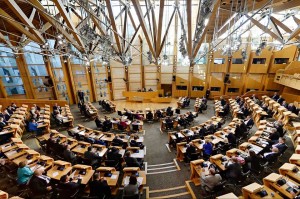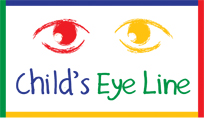Blog
Child’s Eye Line UK secures cross-party support in Scotland and tables amendments to Licensing Bill

November 8th 2014
The Child’s Eye Line UK campaign is celebrating this week after receiving cross-party support at the Scottish Parliament following meetings with ministers and MSPs. The Scottish Shadow Minister for Equalities, Jackie Baillie MSP, has also agreed to table amendments to the forthcoming Scottish Government Licensing Bill on Child’s Eye Line UK’s behalf which would strengthen the Indecent Displays Act to better protect children from sexualisation.
“This is a fantastic result for Child’s Eye Line UK,” said founder Kathy McGuinness who met with the Minister for Children and Young People, Aileen Campbell MSP and MSPs from opposition parties at the Scottish Parliament this week. “We are delighted to have the support of the Minister and other parties and hugely grateful for the Shadow Minister’s agreement to table our amendments. It is great to see Scotland leading the way on child protection and we are hopeful that any new legislation will be adopted across the UK soon.”
The meetings at Holyrood took place almost a year on from the 6 November 2013 Jackie Baillie MSP debate on sexualised images in the media and the concluding remarks of Shona Robison MSP (now Cabinet Secretary for Equalities) that, “Dealing with such issues requires a cultural shift. We must work towards that together, as the Scottish Government cannot change things on its own, despite all the work that we are doing. We need members on all sides of the Parliament to come together and join with the women and men in progressive Scotland who want to make those changes”.
In a meeting with Kathy last month, Home Office Minister for Crime Prevention, Norman Baker MP, confirmed that supermarkets who display magazines and newspapers with sexualized front covers at child height are “not observing current legislation in relation to the Indecent Displays Act 1981.”
Minister Baker has written to the Prime Minister, David Cameron, on Child’s Eye Line UK’s behalf and received a “positive reply.” David Cameron referred Minister Baker to the Bailey Review into the sexualisation of children, “Letting Children Be Children” (commissioned in 2012), which made a series of recommendations that shops and supermarkets should ‘ensure that magazines and newspapers with sexualised images on their covers are not in easy sight of children’.
“The support of the Home Office was fantastic news,” says Kathy. “However, we feel that the law can be strengthened and go further to address the type of challenges the Scottish government’s Cabinet Secretary for Justice, Kenny MacAskill, outlined at the Holyrood conference on Domestic Violence when he spoke of a need for long-term cultural change to achieve the goals of Equally Safe: Scotland’s Strategy for the elimination of Violence Against Women and Girls. This is a hugely important step toward ensuring the long-term culture change towards the sexualisation of children that Shona Robison spoke of.”
Kathy concluded: “I’m hopeful Child’s Eye Line UK will be invited back to Scottish Parliament to give evidence on the Bill and that we can get a further slot in Ministers’ diaries to discuss this vital approach to protecting children.”
Notes to Editors:
About Child’s Eye Line UK:
Child’s Eye Line UK is a national campaign run by volunteer parents fed up of their children being confronted with sexualized and degrading images in their local shops and supermarkets.
The campaign launched a petition in March 2013 which quickly achieved 25,000 signatures and has a busy website, Facebook and Twitter following, cross-party support and the support of all the leading teaching unions and children’s charities.
Child’s Eye Line UK recently had success with The Co-operative group agreeing not to stock lads’ mags and The Sport newspaper, which features pornographic imagery in its front page.
A recent UK government report by the Children’s Commissioner, “Basically Porn is Everywhere” 2013, found that exposure to sexualized images is “damaging to children, negatively affecting their sexual development, relationships and self esteem and makes risky sexual behaviour more likely.” The images and content found in publications like The Sun, The Star, The Sport and lads’ mags were also linked with attitudes that underpin violence against women.
On the 6 November 2013 the Scottish Parliament debated the following motion: That the Parliament notes with concern reports regarding a connection between the portrayal of sexualised images of women in the media and attitudes that reinforce sexist attitudes, sexual harassment, abuse and violence toward women; believes that this has been demonstrated by the United Nations Committee on the Elimination of Discrimination Against Women and the UK Government-commissioned Sexualisation of young people review; welcomes the No More Page 3 campaign, which calls on The Sun to refrain from printing pictures of topless women; applauds the campaign for what it considers a successful first year in operation; recognises that a motion in support of the campaign was agreed by the National Assembly of Wales and that numerous organisations, including UNISON, the British Youth Council, UK Girlguiding, the National Union of Teachers, the National Association of Head Teachers, and the Association of Teachers and Lecturers have also shown their support for the campaign, and notes calls in Dumbarton and across the country for The Sun in Scotland to stop printing pictures of topless women.
http://nomorepage3.org/news/transcript-from-debate-in-scottish-parliament-on-6th-november-2013/
Child’s Eye Line UK has submitted evidence to the forthcoming Scottish Parliament scrutiny of the Air Weapons and Licensing Bill, a copy can be found here: http://www.scottish.parliament.uk/S4_LocalGovernmentandRegenerationCommittee/General%20Documents/29._ChildEyes_UK.pdf
Equally Safe sets out Scotland’s strategy to take action on all forms of violence against women and girls. While the overarching aim is to prevent and eradicate violence against women and girls, it identifies key priority areas. While the strategy sets out some early commitments, it explains how a phased approach will help ensure that the longer-term change is sustained.
http://www.scotland.gov.uk/Publications/2014/06/7483
For more details about this story or Child’s Eye Line UK, please contact:
Kathy McGuinness
Child’s Eye Line UK founder
info@childseyeline.org
www.childseyeline.org
Facebook: https://www.facebook.com/ChildEyes
Twitter: @ChildEyesUK

Follow Us!